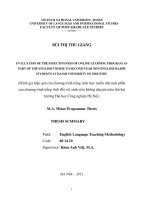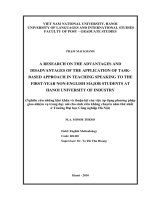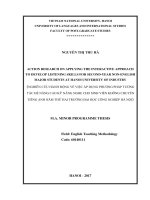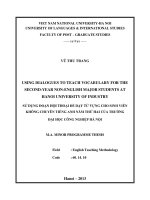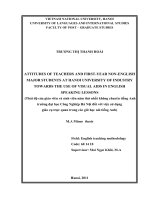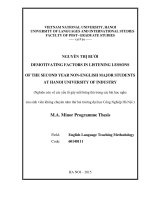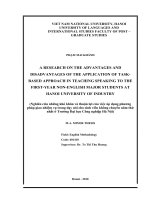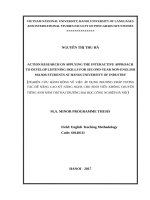Action research on applying the interactive approach to develop listening skills for second year non english major students at hanoi university of industry
Bạn đang xem bản rút gọn của tài liệu. Xem và tải ngay bản đầy đủ của tài liệu tại đây (1.1 MB, 65 trang )
VIETNAM NATIONAL UNIVERSITY, HANOI
UNIVERSITY OF LANGUAGES AND INTERNATIONAL STUDIES
FACULTY OF POST-GRADUATE STUDIES
**************
NGUYỄN THỊ THU HÀ
ACTION RESEARCH ON APPLYING THE INTERACTIVE APPROACH
TO DEVELOP LISTENING SKILLS FOR SECOND-YEAR NON-ENGLISH
MAJOR STUDENTS AT HANOI UNIVERSITY OF INDUSTRY
(NGHIÊN CỨU HÀNH ĐỘNG VỀ VIỆC ÁP DỤNG PHƯƠNG PHÁP TƯƠNG
TÁC ĐỂ NÂNG CAO KỸ NĂNG NGHE CHO SINH VIÊN KHÔNG CHUYÊN
TIẾNG ANH NĂM THỨ HAI TRƯỜNG ĐẠI HỌC CÔNG NGHIỆP HÀ NỘI)
M.A. MINOR PROGRAMME THESIS
Field: English Teaching Methodology
Code: 60140111
HANOI - 2017
VIETNAM NATIONAL UNIVERSITY, HANOI
UNIVERSITY OF LANGUAGES AND INTERNATIONAL STUDIES
FACULTY OF POST-GRADUATE STUDIES
**************
NGUYỄN THỊ THU HÀ
ACTION RESEARCH ON APPLYING THE INTERACTIVE APPROACH
TO DEVELOP LISTENING SKILLS FOR SECOND-YEAR NON-ENGLISH
MAJOR STUDENTS AT HANOI UNIVERSITY OF INDUSTRY
(NGHIÊN CỨU HÀNH ĐỘNG VỀ VIỆC ÁP DỤNG PHƯƠNG PHÁP TƯƠNG
TÁC ĐỂ NÂNG CAO KỸ NĂNG NGHE CHO SINH VIÊN KHÔNG CHUYÊN
TIẾNG ANH NĂM THỨ HAI TRƯỜNG ĐẠI HỌC CÔNG NGHIỆP HÀ NỘI)
M.A. MINOR PROGRAMME THESIS
Field: English Teaching Methodology
Code: 60140111
Supervisor: Assoc. Prof. KIỀU THỊ THU HƯƠNG
HANOI - 2017
DECLARATION
I hereby certify that the minor thesis entitled: “Action research on applying the
interactive approach to develop listening skills for second-year non-English
major students at Hanoi University of Industry”, which is submitted in partial
fulfillment of the requirements for the Degree of Master of Arts in English
Language Teaching Methodology at Faculty of Post-Graduate Studies, Hanoi
University of Languages and International Studies, Vietnam National University, is
the result of my own work. I have provided fully documented references to the work
of others. The material in this thesis has not been submitted for any other university
or institution wholly and partially.
Hanoi, 2017
Nguyễn Thị Thu Hà
i
ACKNOWLEDGTMENTS
First and foremost, I would like to express my deepest gratitude to Assoc.
Prof. Dr. Kieu Thi Thu Huong, my supervisor, for her assistance, encouragement as
well as the guidance she gave me while I was doing this research.
Second, I would like to express my special thanks to all the lecturers of the
Post Graduate Faculty of University of Languages and International Studies,
Vietnam National University, Hanoi for their scholarly knowledge and amazing
lectures that have helped to increase my interest for English Methodology and my
teaching job.
I also wish to show my appreciation to my second-year students of the class
E6.1_K9 for their whole-heated participation in the study.
Last but not least, I owe my sincere thanks to my parents, my younger sister
and my friends who have always inspired and encouraged me to complete this
study.
ii
ABSTRACT
This study aims at investigating the impact of interactive processing on second-year
students’ listening skills at Hanoi University of Industry. More specifically, the
researcher strives to (1) investigate problems that the students may encounter while
learning listening, and (2) examine the effects of applying the interactive process in
teaching listening to the second-year students. To achieve the above mentioned
objectives, an action research is conducted with the participation of 42 second-year
students of class E6.1_K9 within twelve weeks. A pre-test, a post-test and two
questionnaires are used as instruments to collect data for analysis. The findings show that
there are six problems that cause difficulties to students in listening. They are (i) lacking
of vocabulary, (ii) structures of spoken language, (iii) speech rate, (iv) various and
unfamiliar accents, (v) stress and intonation, (vi) lacking of background knowledge
about the topic. After interactive processing has been applied, the students’ scores
in the post-test are higher than in the pre-test. Overall, the instruction of interactive
processing improves their listening skills.
iii
TABLE OF CONTENTS
DECLARATION .................................................................................................. i
ACKNOWLEDGTMENTS ................................................................................ ii
ABSTRACT .......................................................................................................... iii
TABLE OF CONTENTS .................................................................................... iv
LISTS OF FIGURES, CHARTS & TABLES ................................................... vii
PART I: INTRODUCTION ................................................................................ 1
1. Statement of the problem ................................................................................ 1
2. Aims of the study .............................................................................................. 2
3. Research questions ........................................................................................... 2
4. Scope of the study ............................................................................................ 2
5. Methodology of the study ................................................................................ 3
6. Significance of the study .................................................................................. 3
7. Structure of the study ...................................................................................... 3
PART B: DEVELOPMENT ............................................................................... 5
CHAPTER I: LITERATURE REVIEW ........................................................... 5
1.1. Theory on listening ........................................................................................ 5
1.1.1. Definitions of listening ................................................................................. 5
1.1.2. Types of listening ......................................................................................... 6
1.1.2.1. Real-life listening...................................................................................... 6
1.1.2.2. Classroom listening .................................................................................. 7
1.1.3. Listening processes ...................................................................................... 8
1.1.3.1. Bottom-up processing ............................................................................... 8
1.1.3.2. Top-down processing................................................................................ 9
1.1.3.3. Interactive processing_ the inclusion of bottom-up and top-down
processing............................................................................................................... 10
1.1.4. Factors affecting listening processes .......................................................... 11
1.2. Teaching listening skills ................................................................................ 12
1.2.1. Stages of a listening lesson .......................................................................... 12
iv
1.2.1.1. Pre-listening .............................................................................................. 12
1.2.1.2. While-listening .......................................................................................... 13
1.2.1.3. Post-listening ............................................................................................. 14
1.2.2. Interactive processing in teaching listening skills ...................................... 15
1.2.2.1. Teaching bottom-up processing ............................................................... 15
1.2.2.2. Teaching top-down processing ................................................................. 16
1.3. Review of previous works .............................................................................. 17
1.4. Concluding remarks....................................................................................... 19
CHAPTER II: METHODOLOGY .................................................................... 20
2.1. Rationale of the using action research ......................................................... 20
2.2. Research setting ............................................................................................. 21
2.3. Selection of participants ................................................................................ 22
2.4. Data collection instruments ........................................................................... 22
2.4.1. Pre-test and post-test ................................................................................... 22
2.4.2. Questionnaires ............................................................................................. 22
2.5. Data analysis procedures ............................................................................... 23
CHAPTER III: FINDINGS AND DISCUSSION ............................................. 25
3.1. Preliminary investigation .............................................................................. 25
3.1.1. Analysis of students’ preliminary questionnaire. ........................................ 25
3.1.1.1. Students’ attitudes on listening skills. ...................................................... 25
3.1.1.2. Students’ self- assessment of their listening competence ........................ 26
3.1.1.3. Students' use of strategies in listening ...................................................... 27
3.1.1.4 .Student's difficulties in listening .............................................................. 27
3.1.1.5. Students' expectation towards teachers .................................................... 28
3.1.2. Results of students’ pre-test. ........................................................................ 29
3.2. Evaluation ...................................................................................................... 30
3.2.1. Comparison of results from students' pre-test and post-test ....................... 30
3.2.2. Analysis of the students' post questionnaire ................................................ 31
3.2.2.1. Activities motivating students in pre-listening stage ............................... 31
v
3.2.2.2. Activities attracting students in while-listening stage ............................. 32
3.2.2.3. Useful and effective activities for students after listening ....................... 33
3.2.2.4. Students’ opinions about the listening tasks ............................................ 34
3.2.2.5. Students’ opinions on the teaching methods ............................................ 35
3.2.2.6. Students’ opinions on learning listening with the interactive approach .. 36
3.2.2.7. Students’ opinions about their listening skills after the course ............... 36
3.3. Concluding remarks....................................................................................... 37
PART C. CONCLUSION .................................................................................... 37
1. Recapitulation .................................................................................................. 38
1.1. Difficulties students encounter when studying listening skills ................... 38
1.2. The effects of applying the interactive approach to teach listening skills ... 38
2. Implications ...................................................................................................... 39
2.1. The neccessity of applying the interactive approach ................................... 39
2.2. The neccessity of arousing students' motivation and interest ..................... 40
2.3. Changes in conducting three stages of a listening lesson ........................... 40
2.3.1. Pre-listening ................................................................................................. 40
2.3.2. While-listening ............................................................................................. 42
2.3.3. Post-listening ............................................................................................... 42
3. Limitations of the study................................................................................... 42
4. Suggestions for further studies ....................................................................... 43
REFERENCES ..................................................................................................... 44
APPENDIX 1 ......................................................................................................... I
APPENDIX 2 ......................................................................................................... III
APPENDIX 3 ......................................................................................................... V
APPENDIX 4 ......................................................................................................... VII
APPENDIX 5 ......................................................................................................... IX
vi
LISTS OF FIGURES, CHARTS & TABLES
Figures
Figure 1: Action research model .............................................................................. 20
Charts
Chart 1: Students’ attitude on the importance of listening skills ............................. 25
Chart 2: Students’ interest in learning listening skills ............................................. 26
Chart 3: Students’ self-assessment of their listening competence ........................... 26
Chart 4: Students' use of strategies in listening........................................................ 27
Chart 5: Comparison of the results from pre-test and post-test ............................... 31
Chart 6: Students’ opinions on learning listening with the interactive approach .... 36
Chart 7: Students’ opinions on their listening skills after the course ...................... 37
Tables
Table 1:Some kinds of bottom-up exercises for beginners....................................... 16
Table 2:Some kinds of top-down exercises for beginners ....................................... 17
Table 3: Students’ difficulties in learning listening ................................................. 27
Table 4: Students' expectation towards teachers ...................................................... 28
Table 5: The overall results of students’ pre-test ..................................................... 29
Table 6: The overall results of students’ post-test ................................................... 30
Table 7: Activities motivating students in pre-listening stage ................................. 31
Table 8: Activities attracting students in while-listening stage ............................... 32
Table 9: Useful activities for students after listening .............................................. 33
Table 10: Students’ opinions on the listening tasks ................................................. 34
Table 11: Students’ opinions on the teaching methods............................................ 35
vii
PART I: INTRODUCTION
1. Statement of the problem
Recently, listening has gained more and more attention in foreign language
learning. In learning English as a foreign language, it is suggested that the most
important step should begin with an effort to listen. Rubin & Thompson state:
Listening, quite possibly, is the most important of the language skills,
since people spend approximately 60% of their time listening….. In
addition, listening will give you an opportunity to get a “feel” for the
language and will have you improve your overall ability in it. If you
don’t learn to listen effectively, you will not be able to participate in
conservations in the foreign language.
Rubin & Thompson (1994, p. 85)
Rost (1994, p. 141) emphasizes that listening can be regarded as a necessary skill in
the preparation of foreign language students and can even be considered as a good
predictor of language achievement. Consequently, listening plays a vital role in
foreign language learning.
At present, listening is incorporated in all English syllabuses used at all levels of
Vietnamese education. However, there was a long time when most English
textbooks in Vietnam paid attention to grammar, translation and reading materials,
it was almost impossible to find anything related to teaching listening skills. As a
result, listening is considered to be the most challenging skill in teaching and
learning compared to the other skills.
Being a teacher of English at Hanoi University of Industry for more than two years,
the writer has found that the non-English major students are uninterested in
listening lessons. They are unwilling to do any listening tasks and perform poorly in
the listening tests. The question arises here is to find out the suitable approach to
help the students develop their listening skills.
1
The above reasons have encouraged the writer to carry out the study entitled:
"Action research on applying the interactive approach to develop listening skills for
second-year non-English major students at Hanoi University of Industry"
2. Aims of the study
This study is designed with the aim to investigate whether applying the interactive
approach helps students improve their listening skills in English.
In order to achieve this aim, the following objectives are set out for the study:
- To gain the understanding of the difficulties encountered by second-year nonEnglish major students at Hanoi University of Industry in listening lessons.
- To experiment and investigate the effects of using the interactive approach to
teaching listening to second-year non-English major students.
3. Research questions
In order to achieve the objectives above, two research questions are raised:
1. What difficulties do the second-year non-English major students at Hanoi
University of Industry encounter in listening lessons?
2. What are the effects of applying the interactive approach to teaching listening
for second-year non-English major students at Hanoi University of Industry?
4. Scope of the study
There are many methods of teaching listening skills, however, in this study the
researcher intends to use the interactive approach to help second-year non-English
major students at Hanoi University of Industry overcome their difficulties in
learning listening skills. This approach is conducted over a 12-week period and is
applied in the three stages of a listening lesson: pre-listening; while-listening and
post-listening. The sample populations are 42 second-year non-English major
students from class called E6.1_K9 at Hanoi University of Industry.
2
5. Methodology of the study
Conducting the study, the researcher follows the general steps in Nunan's action
research model (1992). She makes use of the quantitative method with the wish to
explore the matter thoroughly. The data are collected from the two following sources:
-
Pre-test and post-test
-
Two survey questionnaires
Pre-test and post-test are used to assess the quality of the participants' listening
performance before and after the research. The two questionnaires are carried out
after the pre-test and post-test, and their aim is to confirm and supplement the results
of the tests.
6. Significance of the study
By bringing out the results of the influence of using the interactive approach to
develop students' listening skills, and providing pedagogical implications in dealing
with the this approach, the study will somehow make the following contributions.
First, the findings of the study may be served as references for the teachers of
English to gear their teaching towards a more effective approach. Moreover, the
popularization of the findings can possibly help the researcher herself and her
colleagues improve their teaching skills.
7. Structure of the study
There are three main parts in this study:
Part A: Introduction, presents the statement of the problem, aims, research questions,
scope, methodology, significance and structure of the study.
Part B: Development, which is divided into 3 chapters:
Chapter I: “Literature review”, sets up theoretical background that is relevant to the
purpose of the study.
3
Chapter II: “Methodology”, indicates the rationale of using action research, the
setting, the selection of participants, the data collection instruments and data analysis
procedures.
Chapter III: “Findings and discussion”, discusses the findings of application of the
interactive approach on teaching and learning listening skills for second-year nonEnglish major student at Hanoi University of Industry.
Part C: Conclusion, summarizes the key issues in the study, gives the implications,
points out the limitations and provides some suggestions for further study.
4
PART B: DEVELOPMENT
CHAPTER I: LITERATURE REVIEW
In this chapter, the writer provides a theoretical background for the study by presenting
the concepts most relevant to the topic. Firstly, a number of theories on listening are
introduced. Secondly, the teaching of listening skills is discussed. Finally, the listening
difficulties for foreign language learners are referred to.
1.1. Theory on listening
1.1.1. Definitions of listening
In terms of listening definitions, Anderson and Lynch (1988) have two
influential views: traditional view and alternative view.
According to the traditional view, listening is regarded as one of receptive skills.
Learners just listen to the messages or recording and try to understand the meaning
of the speakers’ utterances without taking any notice of such factors as attitude and
shades of meaning. This leads to a problem that teachers merely test students’
capacity of hearing, not students’ understanding of the conversation or talk. In this
traditional way, it is thought that teaching listening is for sounds, but not for
meaning. Hence, this view is criticized as inappropriate and inadequate by
Anderson and Lynch (1988).
However, learners are seen as active model builders in the alternative view. New
information and listeners’ own background knowledge are combined to reach full
comprehension of what have been heard. Anderson and Lynch (1988) agree with
this view, which emphasizes the active interpretation and integration of listeners on
incoming information. Littlewood (1981) supports this view as well. The author
remarks that listening requires active involvement from listeners. The nature of
listening comprehension is that the listeners should be encouraged to be engaged in
an active process of listening for meaning, using not only the linguistic cues but
non-linguistic knowledge as well.
5
Listening is viewed as an active process in which individuals focus on selected
aspects of aural input, construct meaning from passages, and then relate what they
have heard to existing knowledge (Bentley & Bacon, 1996). In other words,
listening is an active process of constructing meaning and this is done by applying
listeners’ knowledge to the incoming sounds in which numerous types of
knowledge are involved including linguistic knowledge and non-linguistic
knowledge (Buck, 2001) because “comprehension takes place when input and
knowledge are matched against each other” (Faerch & Kasper, 1986, p. 264).
In short, in order to be successful in listening, it is advisable that "listening
comprehension is not a skill which can be mastered once and for all then ignored
while other skills are developed. There must be regular practice with increasingly
difficult materials" (Wilga, 1986, p. 157).
1.2.2. Types of listening
There are many types of listening. We can classify these according to a number of
variables, including listening purposes, the role of the listener and the types of text
being listened to.
1.2.2.1. Real-life listening
Many students see a big gap between listening activities in classroom and actual
situations. This is because most listening materials including dialogues in textbooks
are very grammar-oriented and controlled in many ways. The speakers often speak
with perfectly controlled speech, voice, tone, accent and correct grammar. Whereas,
in real-life conversations, learners encounter various people with different genders,
ages, accents, speeds, voices, tones. There may be improper usage, incomplete
sentences, redundancy, contractions, overlap and so forth.
There are two ways which people often listen in real-life, they are casual and focus
listening.
6
a) Casual listening
A lot of students have a habit of listening to a radio while studying or the television
is on while they are doing something else. They listen with no particular purpose.
This kind of listening is called casual listening.
b) Focus listening
Focus listening happens when listening for a particular purpose to get the
information we need to know or to study the language. In this case, listeners often
listen with much attention, but they do not listen to everything with equal
concentration. There is an association between listener's expectation and purpose
and his comprehension. If the listener's expectations and needs are intentional, his
listening is likely accurately perceived and understood than which is not relevant or
helpful.
1.2.2.2. Classroom listening
Classroom listening may be divided into two types: intensive listening and
extensive listening.
a) Intensive listening
Intensive listening is the careful, focused listening to a short passage for detailed
information or full comprehension; For example, listening to a dialogue on the tape
to study its structures, intonation patterns in an English class.
b) Extensive listening
Extensive listening is freer and more general listening to natural language or general
ideas, not for particular detail or not necessary under the teacher's guidance. The
listening passage for extensive listening can be long or short. The language that is
used in the type of listening is often within the students' ability so that they find it
pleasing and interesting when they are listening. With this type of listening, students
are not reinforcing a structure or practicing a grammar point linked to the rest of the
course.
7
1.1.3. Listening processes
So far, many linguists have carried out studies on listening skills such as Anderson
and Lynch (1998), Underwood (1989) or Brown (1990). All of them are of the view
that listening process is not a simple process of a single activity but a complex one
consisting of various activities. After hearing a process with various stages
involving physical processing of the auditory system with the outer ear, the middle
ear, the inner ear, the nerve impulses and so on, the listening process occurs inside
the brain with a lot of sub-processes.
In terms of the nature of those sub-processes, Van Duzer (1997) suggests nine
successive activities in listening process.(1) determining a reason for listening; (2)
taking the raw speech and deposits a image of it in short-term memory; (3)
attempting to organize the information by identify the type of speech event ( a
conversation, a lecture , a radio advertisement) and the function of the message ( to
persuade/ inform/ request); (4) predicting information expected to be included in the
message; (5) recalling background information (schemata) to help interpret the
massage; (6) assigning a meaning to the message; (7) checking that the message has
been understood; (8) determining the information to be held in long-term memory;
and (9) deleting the original form of the message that has been received into shortterm memory.
Looking at the issue from other perspectives, other scientists assign listening
process to a parallel processing model with bottom-up processing and top-down
processing.
1.1.3.1. Bottom-up processing
Nunan (1992) regards the bottom-up processing model as a listening process of
decoding the sounds that one hears in a linear fashion, from the smallest meaningful
units (phonemes) to complete texts. In this view, phonemic units are decoded and
linked together to form words, words are linked together to form phrases, phrases
are linked together to form utterances, and utterances are linked together to form
8
complete, meaningful texts. Therefore, students need to know the code in order to
decode sounds. The code consists of how the sounds work, how they string together
and how the code can change in different ways when it is strung together. This
process is a linear one in which meaning itself is derived as the last step. It is called
listeners as tape recorder view of listening because listeners take in and store
messages consecutively, in much the same way as a tape recorder: one sound, one
word, one phrase, and one utterance at a time (Anderson & Lynch, 1988).
Moreover, the ways showing how the linguistic competence of a listener works to
'build' the comprehension of a message are described by bottom-up processes.
According to Peterson (2001), these are the lower level processes that work to
construct the meaning from the recognition of sounds and words, which, when
identified, are fit into larger phrasal units and then match with related ideas stored in
long-term memory. Therefore, at lower levels of language proficiency, the
activation of bottom-up processing is thought to impose a great strain on conscious
attention and working memory.
1.1.3.2. Top-down processing
Top-down processing is another alternative to teaching listening instead of bottomup processing. According to Nunan (1992), this process allows listeners to actively
construct (or more accurately, reconstruct) the original meaning of the speaker
using incoming sounds as clues. In the reconstruction process, listeners use their
prior knowledge of the context and situation within which the listening process
takes place to make sense of what he or she hears.
Nunan (1992) explains that such things as knowledge of the topic, the speaker or
speakers, their relationship to the situation, and prior events are all related to the
context and situation. Similarly, Richards (1990) points out that the background
knowledge required for top-down processing may be previous knowledge about the
topic of the discourse, situational or contextual knowledge, or knowledge in the
form of schemata or scripts - plans about the overall structure of the events and
relationships between them.
9
In other words, top-down processing refers to how listeners use their world
knowledge to attribute meaning to language input; how their knowledge of social
convention helps them understand meaning. Listeners apply top-down processing
when using their context and prior knowledge like topic, genre, culture, and other
schema knowledge in long-term memory to build a conceptual framework for
comprehension.
1.1.3.3. Interactive processing: the inclusion of bottom-up and top-down
processing
Interactive processing is the inclusion of bottom-up and top-down processing. The
combination is necessary as pointed out by Mendelsohn (2001), bottom-up is not
fulfill, in real-life listening we listen in different ways, depending on our purpose
for listening. Therefore, learners need to balance top-down with bottom-up
strategies during the listening comprehension process. While a top-down approach
helps learners develop real-life listening skills, bottom-up helps them develop word
recognition skills.
Osada (2001) attributes the lack of success in listening to an overemphasis on
bottom-up skills. Basing on his analysis of answers to question on idea unit
analysis, he find that low-proficiency Japanese students of English tend to adopt a
mental translation approach to listening. He argues for more emphasis on a topdown approach because beginner level listeners cannot construct meaning when
they process connected speech on a word-by-word basis only, so they use previous
knowledge in order to contextualize a situation.
On the other hand, Hulstijin (2001), suggests that the development of top-down
strategies is inadequate for linguistic input to become an intake for second language
learning. He also argues that bottom-up skills need to be developed at the
beginners’ level, so that all the components of the acoustic signal become
meaningful units for the listener. Moreover, he states that bottom-up and top-down
strategies do not act independently; while the relationship between both is not fully
understood, it is clear that there is some sort of compensatory relationship between
10
them, just in case one process does not work effectively, the other will assist the
listeners in order to have a meaningful listening comprehension.
Nunan (2002) clarifies that listening comprehension is neither top-down nor
bottom-up processing. It is an interactive process where listeners employ both prior
knowledge and linguistic knowledge to make sense of the incoming message, it is
necessary that learners get an awareness of how to use those learning strategies in
efficient and effective ways.
From the results of the above studies, it can be concluded that bottom-up processing
and top-down processing are two well-integrated parts of the comprehension. In
other words, interactive processing, an inclusion of the bottom-up and top-down
processing is a good method for teaching and learning listening.
1.1.4. Factors affecting listening processes
Underwood offers seven conceivable causes of obstacles to efficient listening
comprehension. (1989, p. 16).
First, listeners cannot control the speed of what they hear. Listeners often feel that the
utterances disappear before they can sort them out or they can get the message. When
they fail in sorting out the meaning of one part, the following will be missed. This can
lead to the ignorance of the whole chunk of discourse.
Second, listeners cannot always have words repeated, which is a serious problem in
learning situations. In the classroom, the decision as to whether or not to replay a
recording is not in the hands of the students. Teachers decide what and when to
repeat listening passages. However, it is hard for the teacher to judge whether or not
the students have understood any particular sections of what they have heard.
Third, listeners have limited vocabulary. The speaker may choose words listeners
does not know. Listeners sometimes encounter an unknown word, which may cause
them to stop and think about the meaning of that word, so they miss the next part of
the speech.
Fourth, listeners may fail to recognize the signals, which indicate that the speaker is
moving from one point to another, giving an example, or repeating a point.
11
Discourse markers used in formal situations or lectures such as “secondly” or
“then” are comparatively evident to listeners. In informal situations or spontaneous
conversations, signals are vaguer such as pauses, gestures, increased loudness, a
clear change of pitch, or different intonation patterns. These signals can be easily
missed, especially by less proficient listeners.
Fifth, listeners may lack contextual knowledge. Sharing mutual knowledge and
common context makes communication easier. Even if listeners can understand the
surface meaning of the text, they may have considerable difficulties in
comprehending the whole meaning of the passage unless they are familiar with the
context. Nonverbal cues, such as facial expression, gestures, or tone of voice, can
also be easily misinterpreted by listeners from different cultures.
Sixth, it may be difficult for listeners to concentrate in a foreign language. In
listening comprehension, even the shortest break in attention can seriously impair
comprehension. Concentration is easier when students find the topic of the listening
passage interesting; however, learners sometimes feel that listening is very tiring
even if they are interested as it requires an enormous amount of effort to follow the
meaning.
Seventh, learners may have established certain learning habits such as a wish to
understand every word. In some cases teachers want learners to understand every
word they hear by repeating or speaking slowly. Consequently, learners tend to
become worried if they fail to understand a particular word or phrase and then get
discouraged by their failure. It is thus sometimes necessary for learners to tolerate
incompleteness of understanding.
1.2. Teaching listening skills
1.2.1. Stages of a listening lesson
1.2.1.1. Pre-listening
According to Davies and Pearse (2000), it is useful to prepare the learners for what
they are going to hear, as it arouses students’ interest and provides students with the
purposes of listening, just as we usually prepare for real-life situations.
12
With the aim is setting-up certain knowledge before listening to help the students
get the most of what they are going to hear. The main purposes of this stage,
therefore, are:
- To motivate students to pay more attention to the listening text.
- To activate or build students' prior topical and linguistic knowledge. It is
important for students to be able to relate what they already know to the
speaker's content.
- To help the students match what they hear with their stored knowledge by
activating their prior knowledge about the coming topics.
- To set purposes for listening: When students set purposes for listening, they
become active listeners who listen for something, not to it.
These purposes can be achieved by one of the following activities: the teacher
introduces the listening topic, gives background information, gives clear
instructions for the while-listening activity; or the students are given guidance on
the structure of what they are going to hear, discuss the topic situation, look at
pictures, read through the questions if asked. Each of the above activities will help
the students focus on the main points of listening passage by narrowing down the
things that the students expect to hear and activating their previous knowledge.
1.2.1.2. While-listening
The while-listening stage involves activities that students are asked to do during the
time they are listening to the text. The purpose of while listening activities is to help
students develop their skills of eliciting messages from spoken language. Rixon (1986)
points out the purposes of while-listening stage are to challenge and guide students to
handle the information and the message from the listening text. Therefore, activities of
this stage must be interesting and carefully chosen.
To be effective activities, these while-listening ones should possess the two
following characteristics. Firstly, they should be interesting enough to make the
students want to listen and complete the activities. Secondly, they should be things
that are within the capacity of most students. It is advisable to provide while-
13
listening activities which are a challenge for the more advanced students, but do not
discourage those who only gain little success.
Like choosing pre-listening activities, as suggested by Underwood (1989), the
teachers must consider a number of factors when choosing while-listening activities
as follows: the possibilities for varying the level of difficulty if needed, the
convenience of carrying out activities which need individuals to give oral responses
in the classroom, the possibility for the work to be done with the teacher present or
as self-study and either in a listening center or at home, materials or ideas which
might be used for post-listening work, immediate feedback on the extent to which
the students have succeeded in the task
1.2.1.3. Post-listening
Post-listening stage relates to the activities which are done after the listening is
completed. Some post-listening activities are extensions of the work done at the prelistening and while-listening stages and some relate only loosely to the listening text
itself. This stage is also very important, with certain purposes as well as activities.
According to Underwood (1989), the first purpose of post-listening activities is to
check how well the students understood and whether they have completed the
listening task. The second purpose of the post-listening work is to reflect on why
some students have failed to understand or miss parts of the passage. Another
purpose of post listening activities is to expand the topic or the language of the
listening text. The fourth purpose is to give students the opportunity to consider the
manner and attitude of the speaker in the listening text.
To achieve these above-mentioned purposes, the followings are possible activities:
- Teachers give the answers orally, or show the answers on the black board
- Teachers draw the students' attention to specific parts of the listening text and
focus on the forms and function, lexis, stress and intonation which have
caused problems to the students
- Students work in pairs to check each other's answer or in groups to discuss any
problems related to the listening text.
14
1.2.2. Interactive process in teaching listening skills
Listening is an active and complex process, therefore, it requires listeners’
conscious use of strategies and should involve the parallel interaction between
bottom-up and top-down processing. This interactive process is known as parallel
processing which requires learners to use background knowledge (top-down) to
interpret meaning and linguistic knowledge (bottom-up) to discriminate between
familiar sounds. The goal is for the language listeners to use parallel processing in
order to perceive, interpret, and respond to the information being heard (Lynch &
Mendelsohn, 2009, p. 185).
The degree to which listeners use the one process or the other depends on their
knowledge of the language, the familiarity with the topics or the purpose of
listening. For example, listening for gist involves primarily top-down processing,
whereas listening for specific information, as in a weather broadcast, involves
primarily bottom-up processing to comprehend all the desired details. More
specifically, the teaching of bottom-up processing and top-down processing will be
presented in the following sections.
1.2.2.1. Teaching bottom-up processing
Brown (2007, p. 312) notes that bottom-up processing "focuses on sounds, words,
intonation, grammatical structures, and other components of spoken language".
Therefore, learners need a large vocabulary and good working knowledge of sentence
structures to process the bottom-up texts.
Exercises that require bottom-up processing develop the learner’s ability to do the
following:
- Retain input while it is being processed.
- Recognize word and clause divisions.
- Recognize key words.
- Recognize key transitions in a discourse.
- Recognize grammatical relationships between key elements in sentences.
- Use stress and intonation to identify word and sentence functions.
15
Peterson (1991, p. 114-121) suggests several techniques for teaching listening
comprehension. Below are some kinds of bottom-up exercises for beginners.
Goal
Discriminating
between
intonation
contour in sentences
Example
- Listen to a sequence of sentence patterns with either
rising or falling intonation. Place a check in column 1
(rising) or column 2 (falling), depending on the pattern
you hear.
Discriminating
between phonemes
- Listen to pairs of words. Some pairs differ in the final
consonant, and some pairs are the same. Circle the
word "same" or "different", depend on what you hear.
Selective listening for
morphological endings
- Listen to a series of sentence. Circle "yes" if the verb
has -ed ending, and circle "no" if it does not.
Selecting details
- Match a word that you hear with its picture.
from the text (Word
- Listen to a weather report. Look at a list of words and
recognition)
circle the words that you hear.
- Listen to a sentence that contains clock time. Circle the
clock time that you hear, among three choices
- Listen to an advertisement, select the price of an item,
and write the amount on a price tag.
- Listen to a series of messages from an answering
machine. Fill in a chart with the following information
from each caller: name, number, time and message.
Listening for normal
sentence word order
- Listen to a short dialogue and fill in the missing words
that have been deleted in partial transcript.
Table 1: Some kinds of bottom-up exercises for beginners
1.2.2.2. Teaching top-down processing
The top-down processing deals with how listeners use their context and prior
knowledge (topic, genre, culture, and other schema knowledge in long-term
memory) to build a conceptual framework for comprehension.
16
